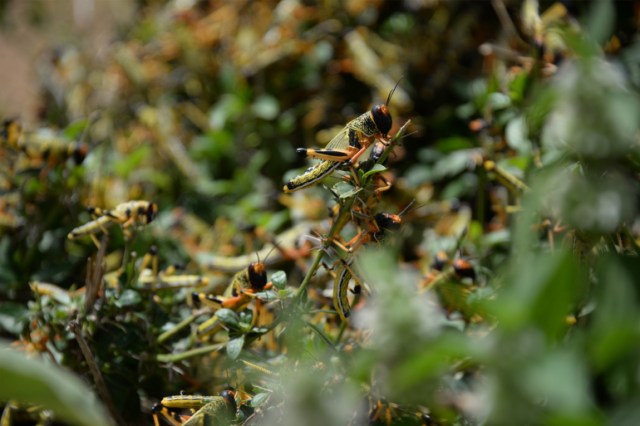The locust swarms returned again 3 weeks ago to Yemen, and the locusts traveling along the wind made their way through the fields, destroying entire crops within no time.
Not
farmers - such as Ali Saleh Hanash , who lives in Shabwa province in the south Alemena- effective means to resist these voracious insects, says , "We use the means obsolete, Venhfr cracks in the soil and burn tires, but pesticides are the only solution to eliminate This flying locust, we can't get it. "
And
it should become the regions of East Africa and South Asia, this control swarms of hungry locusts which devour their crops.
Although locusts prefer plants that grow in the barren desert, they also feed on grains, fruits, vegetables, or pasture grass, as farmers release their livestock to graze.
Tremendous effect
Keith Chrisman, an expert with the United Nations Food and Agriculture Organization (FAO), charged with tracking locust movements, says The locust swarms have had a tremendous impact on the resources of the people on which they live, and millions of people in these areas do not have enough food even before the locust attacks.
The reason
for this influx of locust swarms due to the occurrence of two hurricanes, and caused them large amounts of rain over the Arabian Peninsula in the months of May / May and October / October 2018, and this led during the period of about 9 months to the occurrence of ideal conditions for the proliferation of Locusts. Cressman
explains the
result was an increase by 8 thousand twice the normal numbers, and since then migrated Squadrons to all sides: north to Iran, and to Uganda in the south - west direction, and India to the east.
Says
Cressman "these days is quite suitable for the movement of locust swarms, they can travel for a distance of up to 150 kilometers with the help of strong winds."
And witnessing
many eastern countries of Africa is currently the worst wave of desert locust waves for decades, particularly Ethiopia, Somalia, Kenya, Djibouti, Eritrea, Uganda, Sudan and South Sudan.
And
now it grows a second generation of desert locusts in East Africa, and could become more destructive than the previous generation.
It does not
seem that there is no end in sight to this vicious circle, and in the case of continuing rains could locusts put their eggs again to grow a new generation, and the only chance to resist it is pesticides regularly sprayed, and waiting for the decline in rainfall, as Kenneth Mwangi explains expert Institute of Climate for East Africa, and says, "Then the number of locusts will decrease steadily, and this is what we hope to achieve."
Pakistan
Likewise, farmers in South Asia struggle to combat these fierce insects; In Pakistan, locusts have spread to nearly a quarter of the country's states, according to a spokesman for the National Disaster Management Agency, an excellent piercer.
It was
sprayed more than 6 thousand square kilometers of land with pesticides with the help of the army, and took about three thousand workers in the work of the resistance in the state of Punjab (central Pakistan) , which is a basket of the country 's grain. High temperature at the level of the world
may the
severity of the crisis, and in this regard , the researcher says entomologist Elias Loghmani The high temperature provides ideal conditions for locust breeding, and became States that have been affected by the deal with the real reason , Be it sooner or later.

